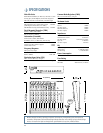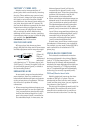
25
Signals passing through the
AUX RETURN
level
controls will proceed directly to
MAIN
MIX
, with one exception (see next para-
graph). The
AUX RETURNS
do not have
MUTE/ALT 3-4
switches, so if you want
these signals to get to the
ALT 3-4
mix, you’ll
have to patch the effects device’s outputs
into one of the stereo channels, and
MUTE/
ALT
that channel .
EFX TO MONITOR
The idea behind this great feature is simple:
If you want to add reverb or delay to the stage
monitor mixes, this is the switch for you. The
implementation leading up to the switch is the
tricky part:
With the switch up,
AUX RETURN 1
and
2
behave normally — they deliver their signals
into the
MAIN MIX
. With the switch down,
AUX RETURN 1
still behaves normally, but
AUX RETURN 2
’s level
control will feed
AUX
SEND
1
instead of the
MAIN MIX
.
Still with us? Good. So far, with the switch
down, we have
AUX RETURN 1
feeding the
MAIN MIX
and
AUX RETURN 2
feeding
AUX
SEND 1
. Now, suppose you only have one ef-
fects device, and you want it to feed both the
MAIN MIX
and
AUX SEND 1
. That’s where
“jack normalling” comes in.
JACK NORMALLING
Jack normalling (not to be confused with
Jack Normalling, Chicago Cubs utility infielder,
1952-61, .267 LBA) is a feature found on al-
most every mixer, keyboard and effects device.
These jacks have special spring-loaded pins
that connect to the signal pins, but when
something is plugged into the jack, that con-
nection is broken.
These normalling pins can be used in all
sorts of ways. The ubiquitous phrase “
LEFT
(
MONO
)” means that if you plug a signal into
the
LEFT
side and have nothing in the
RIGHT
side, that signal is also fed to the right input,
courtesy of jack normalling. As soon as you
plug something in the
RIGHT
side, that
normalled connection is broken.
How does all this relate to the
EFX TO
MONITOR
switch?
AUX RETURN 1
’s inputs
are normalled to
AUX RETURN 2
. If you have
one effects device, plug it into
AUX RETURN 1
.
Plug nothing into
AUX RETURN 2
. Now the
signals feeding the
AUX RETURN 1
inputs will
also be sent to the
AUX RETURN 2
inputs.
Engage the
EFX TO MONITOR
switch, and
now the
AUX RETURN 2
knob will become an
additional
AUX SEND 1
knob for the signal at
the
AUX RETURN 1
. Say that ten times!
Once again,
AUX RETURN 1
will behave nor-
mally, as always.
Congratulations! You’ve just read about all
the features of your 1402-VLZ
PRO. You’re
probably ready for a cold one. Go ahead. The
rest of the manual can wait.
MODIFICATIONS
For most folks, the 1402-VLZ PRO works just
fine the way it is. But for special applications,
there are three signal routing changes that can
be performed easily on the 1402-VLZ PRO. Easy
for someone with soldering experience, that is.
If you don’t know how to solder, find a techni-
cian that can. This is NOT a good place to learn!
• Modification A changes AUX SEND 2 to be
pre-fader, pre-mute instead of post-fader,
post-mute.
• Mod B changes AUX SEND 1 (in post
mode) and AUX SEND 2 to receive signal
regardless of the channel’s MUTE/ALT
switch position, but still be post-fader
(GAIN knob).
• Mod C changes the SOURCE matrix’s
MAIN MIX selection to tap the stereo
signal before the MAIN MIX level control
(pre) instead of after (post).
Instructions for performing these modifications
can be found on our website at www.mackie.com
(click on Support). Or you can call Tech Support
at 1-800-258-6883 for assistance.


















